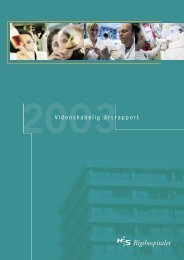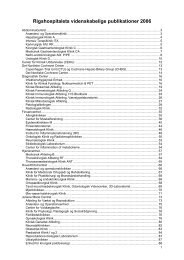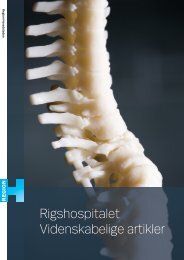View - CTU
View - CTU
View - CTU
Create successful ePaper yourself
Turn your PDF publications into a flip-book with our unique Google optimized e-Paper software.
Bj¢rndal & Reit Endodontic treatments In DK<br />
Endodontic treatm<br />
populations. However, endodontic epidemiological<br />
surveys have mainly reported on the number of root<br />
filled teeth in various populations, while the time<br />
trend, in terms of annual treatment frequency, has<br />
attracted only scarce interest (for a review see Eriksen<br />
et al. 2002).<br />
The prevalence of caries among Danish children has<br />
followed the international trend and decreased during<br />
the last three decades (Bille et al. 1986). Poulsen &<br />
Malling Pedersen (2002), for example, found that the<br />
mean of decayed, missed and filled surfaces (DMFS) in<br />
15-year-old boys and girls changed from 6.68 in 1988<br />
to 3.24 in 2001. The oral health status of the adult<br />
Danish population has also improved considerably<br />
during the past 15 years using the number of natural<br />
teeth present and the frequency of dental visits as oral<br />
health indicators (Petersen et al. 2003).<br />
As a result of an economic agreement between the<br />
Danish Dental Association (DDA) and the Danish<br />
National Health Insurance (DNHI) in 1973, a nationwide<br />
database was established. This database includes<br />
registrations of almost all dental diagnostic, prophylactic<br />
and therapeutic procedures performed in Danish<br />
adults since 1977. The aim of the present report was to<br />
explore the hypothesized long-time decrease of endodontic<br />
treatment frequency in a population with low<br />
caries prevalence, by analysing data from 19 7 7 to<br />
2003 in the register of the DNHI.<br />
Materials and methods<br />
The database<br />
In 1973, an economic agreement was made between<br />
the DDA and the DNHI, implying that parts of the<br />
dental treatment costs for adult patients were to be<br />
funded by the DNHI. In order to receive government<br />
fees, dentists had to make a report to a central register.<br />
In 1977 a database became available, reflecting the<br />
dental service pattern from almost all general dental<br />
practitioners (GDP) treating adult patients in Denmark<br />
(Schwarz 1996). From 1977 to 1999, the fees for<br />
dental treatments were fixed, and the NHI-funded part<br />
for endodontic treatments accounted for about 40%.<br />
From 1999, only the part funded by the NHI was fixed.<br />
The annual number of actual and potential users<br />
(in this study defined as individuals 220 years of age)<br />
of the DNHI system is displayed in Fig. 1 (Danmarks<br />
Statistik - http://www.statistikbanken.dk). Over the<br />
years, the number of actual users increased by 16%<br />
and the potential users by 14%. In the first 10-year<br />
period of the database (1977-1987), only the number<br />
of performed treatments was recorded. Therefore, the<br />
number of patients in the files had to be estimated. Each<br />
patient, who actually went to a dentist during these<br />
years, received an average of 1.5 dental examinations,<br />
and on this basis the number of patients was estimated<br />
(Schwarz 1996).<br />
Recorded treatment procedures<br />
I. Root filling: In the register treatments were basically<br />
recorded per canal and not per tooth. However, a<br />
specific fee was received for the first canal of a tooth<br />
allowing a distinction to be made between the annual<br />
number of treated teeth and treated canals. In the<br />
number of 'root fillings', cases treated with endodontic<br />
surgery are also included. Information was not available<br />
regarding pulpal and periapical diagnosis.<br />
2. Tooth el>.'i:raction: Surgically removed teeth were not<br />
included.<br />
3. Pulpotomy.<br />
4. Pulp capping: DNHI funding started 1992.<br />
5. Stepwise excavation: This treatment was included in<br />
the economic agreement in 1999, and was recommended<br />
when a deep carious lesion was clinically judged to<br />
lead to pulp exposure.<br />
Patient characteristics<br />
From the register, patient characteristics as gender and<br />
age were available as total counts in 19 96, and as<br />
relative counts (per 1000 patients) in 1998.<br />
Statistics<br />
Time trends were statistically examined by linear<br />
regression analysis. Using the slope of the line of the<br />
regression (p) the analysis produced an estimate of<br />
growth per year and a 9 5 % confidence interval ( ~ ± 2<br />
SD). The null hypothesis (no growth) was rejected<br />
when P was less than 0.05. Positive values of~ indicate<br />
positive gr01.vth, whereas negative values of p indicate<br />
negative growth.<br />
Results<br />
Root fillings<br />
The DNHI recorded 268 223 root filled canals in 1977<br />
and 364 867 in 2003, corresponding to a 36%<br />
increase. The number of root filled teeth increased<br />
1979<br />
from 160 119<br />
(20% increase:<br />
formed root I<br />
increased num<br />
system (Fig. 1)<br />
number of root<br />
increase of 1 n<br />
The ratio be<br />
and teeth incr·<br />
(p = 0.014 ±I<br />
and more mu!<br />
period.<br />
The distribu<br />
over age and<br />
Endodontic tre<br />
age groups wit<br />
patients betwe1<br />
last 6-8 years,<br />
1976<br />
Figure 2 The m<br />
observed per 10<br />
number of patier<br />
actual figures rer<br />
© 2004 International Endodontic Journal<br />
International Endodontic Journal, 37, 782-788, 2004<br />
International Endodo








